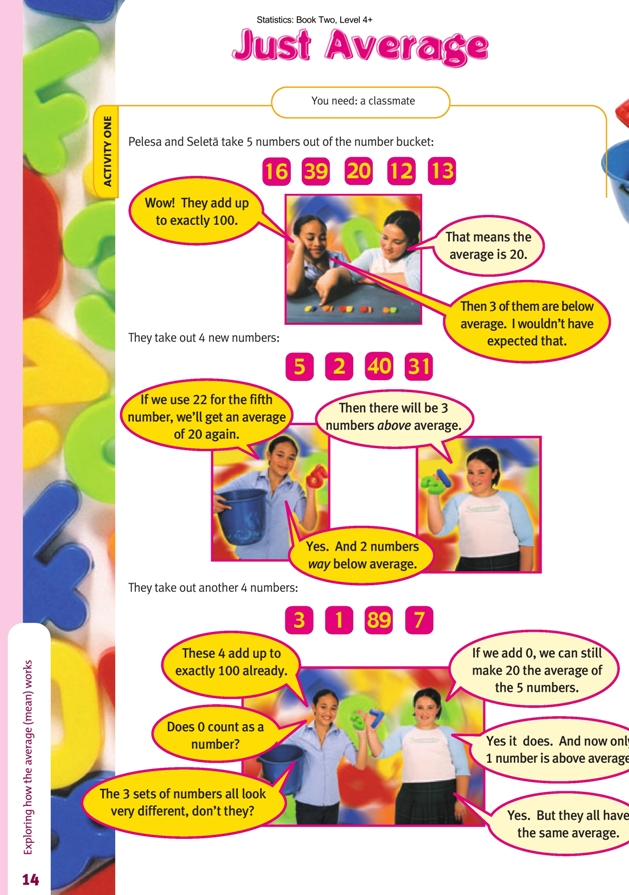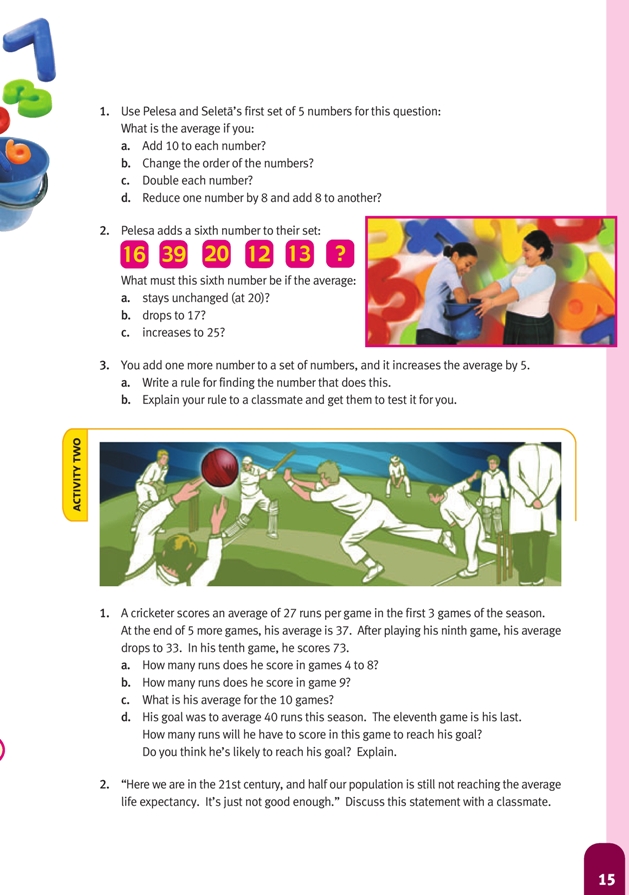Just Average
This is a level 5 statistics activity from the Figure It Out series.
A PDF of the student activity is included.
Click on the image to enlarge it. Click again to close. Download PDF (652 KB)
calculate averages from data sets
A classmate
By now, your students will have had some experience of calculating the means of different data sets. This task challenges them to investigate the way in which each item in a distribution influences the mean (the one value selected to represent the whole distribution). To do this, they must work backwards from the mean to the data set.
Note that the term average is used here instead of mean because it is more commonly used in such contexts. The conversation on page 14 sets up the activity, and the students should read it to find the following “mean messages”:
• Although the mean is a kind of “middle”, the amount of numbers above and below the mean can be very different. (Unlike the median, the mean does not usually split a distribution into two equal halves.)
• The mean of a distribution in which all the numbers are similar can be exactly the same as the mean of a distribution in which the numbers are very different.
• Zero is a number, and the inclusion of 0 in a distribution affects the mean.
The “mean messages” in question 1 are:
• If you add or subtract the same amount to or from every number, you do the same to the mean.
• Changing the order of the numbers in a distribution has no effect on the mean.
• If you multiply or divide each number in a distribution by an amount, the mean is multiplied or divided by the same amount.
• If you alter the numbers in a distribution in compensatory way (for example, if you add 8 to one number and take 8 off another), the mean will not change.
You could encourage your students to answer questions 1–2 by reasoning and then to check their reasoning by calculation.
Questions 2 and 3 challenge the students to think in reverse and to generalise their findings.
Activity Two
Like the questions in the first activity, question 1 helps students to understand the effect on the mean of adding further numbers to a data set. The Answers work through the mathematics of the cricket game step by step. Question 2 challenges students to take care when using the concept of “below average”.
Answers to Activities
Activity One
1. a. 30
b. 20
c. 40
d. 20
2. a. 20
b. 2. (17 x 6 = 102; 102 – 100 = 2)
c. 50
3. a. Rules will vary, but one rule would be: First find the average of the set of numbers you start with. The extra number will be equal to this average plus 5 times the number of numbers that are now in the set.
b. Practical activity
Activity Two
1. a. 215 runs. (Over 8 games, his average is 37, so he has made 8 x 37 = 296 runs in total. But his average for the first 3 games was 27, so he scored 3 x 27 = 81 runs in those games. This means that he scored 296 – 81 = 215 runs in games 4–8.)
b. 1 run. (After playing his 9th game, his average was 33, so his total runs are 9 x 33 = 297. This means that he scored 297 – 296 = 1 run in the 9th game.)
c. Over the 10 games, he scored 297 + 73 = 370 runs, so his average at that point was 370 ÷ 10 = 37 runs.
d. 70. (If he is to average 40 over 11 games, he will need to score a total of 11 x 40 = 440 runs. As he has 370 after 10 games, he needs to score 440 – 370 = 70 runs in his final game for the season.) There is not enough information to be able to say
with confidence that he is or is not likely to reach his goal. If we consider only his average, it appears unlikely that he will, but it is possible that there are several 70s “hidden” in the average (there could be three in games 4–8), and he may
even be returning to form, in which case it would be possible that he will reach his goal.
2. Half of any normally distributed population will be below the median on any measure because, by definition, the median is the mid-point. For a large population, the median and the mean (average) will be extremely close. So of course this means that half the population will not reach the average life expectancy, regardless of what it is. The statement shows that the speaker does not understand the meaning of the word “average”.

